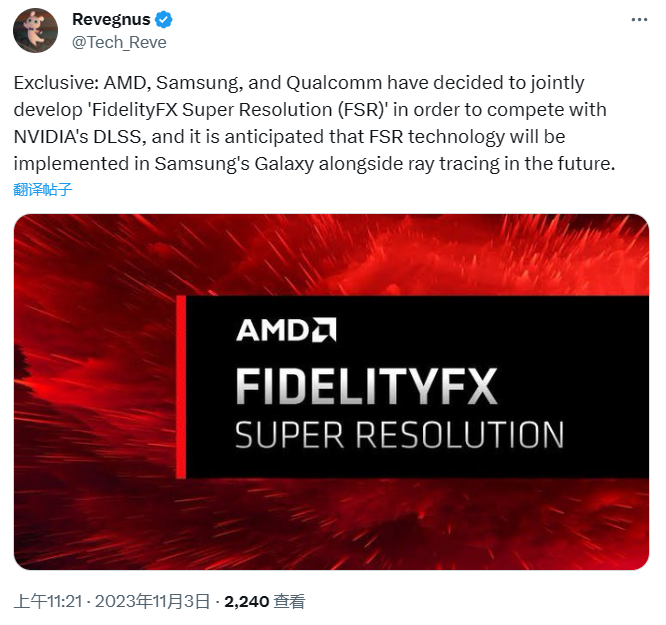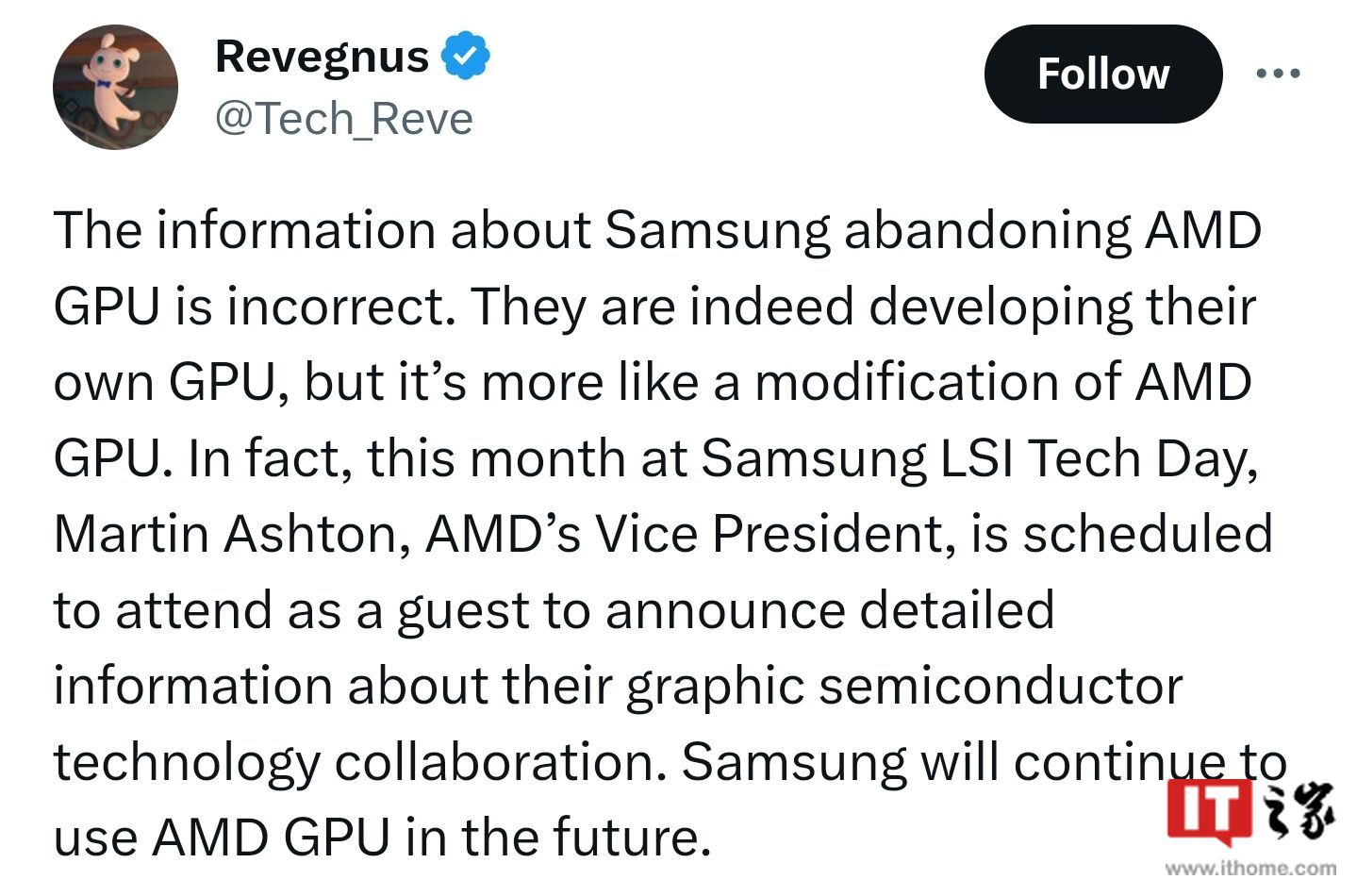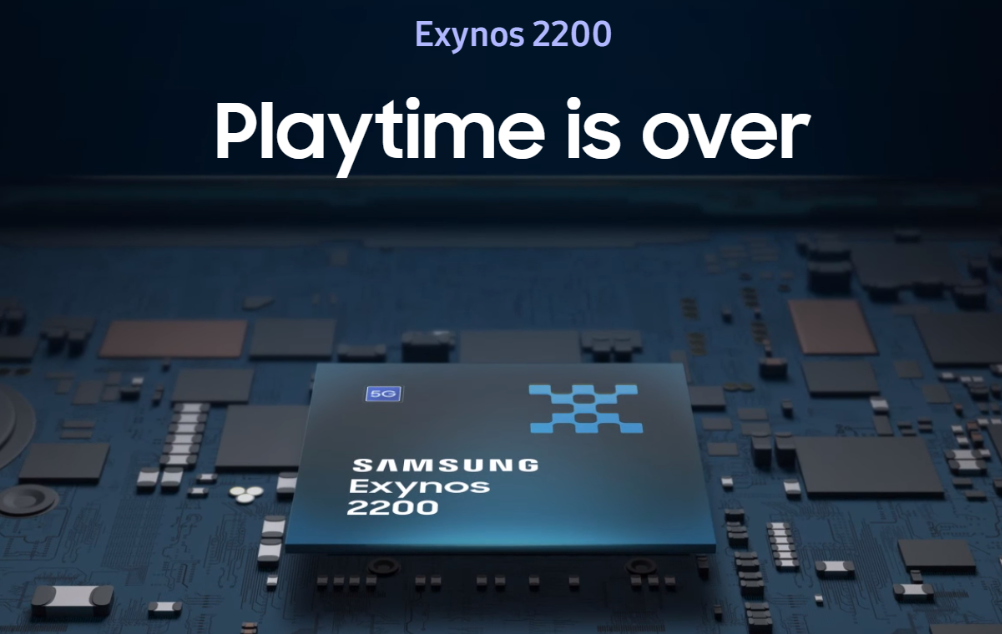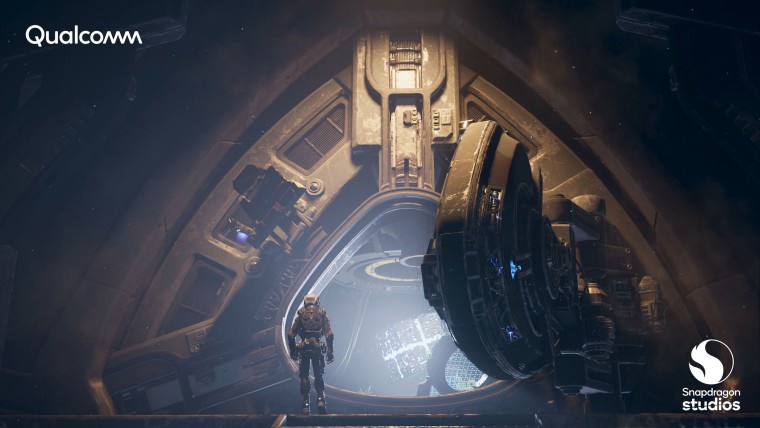 Technology peripherals
Technology peripherals
 It Industry
It Industry
 AMD, Samsung and Qualcomm team up to develop FSR technology to compete with NVIDIA DLSS
AMD, Samsung and Qualcomm team up to develop FSR technology to compete with NVIDIA DLSS
AMD, Samsung and Qualcomm team up to develop FSR technology to compete with NVIDIA DLSS
News from this website on November 3, according to the latest news from the whistleblower @Tech_Reve, AMD, Samsung, and Qualcomm will cooperate to develop FSR game super-resolution technology, Competing with NVIDIA DLSS, it is expected to be equipped with FSR technology and ray tracing in Galaxy phones.

Currently, AMD is cooperating with Samsung on Exynos flagship chips, equipped with RDNA architecture GPUs. @Tech_Reve also previously said that Samsung is developing its own GPU, which is more like a modified version of AMD GPU.



The above is the detailed content of AMD, Samsung and Qualcomm team up to develop FSR technology to compete with NVIDIA DLSS. For more information, please follow other related articles on the PHP Chinese website!

Hot AI Tools

Undresser.AI Undress
AI-powered app for creating realistic nude photos

AI Clothes Remover
Online AI tool for removing clothes from photos.

Undress AI Tool
Undress images for free

Clothoff.io
AI clothes remover

AI Hentai Generator
Generate AI Hentai for free.

Hot Article

Hot Tools

Notepad++7.3.1
Easy-to-use and free code editor

SublimeText3 Chinese version
Chinese version, very easy to use

Zend Studio 13.0.1
Powerful PHP integrated development environment

Dreamweaver CS6
Visual web development tools

SublimeText3 Mac version
God-level code editing software (SublimeText3)

Hot Topics
 1371
1371
 52
52
 How to enable dlss? dlss opening strategy
Mar 13, 2024 pm 07:34 PM
How to enable dlss? dlss opening strategy
Mar 13, 2024 pm 07:34 PM
There is a dlss function in NVIDIA. After users turn on dlss, the game frame rate can be greatly improved. Therefore, many friends are asking the editor how to turn on dlss. First, make sure that the graphics card supports dlss and the game supports dlss, then you can enable it in the game. Let’s take a look at the specific tutorials below. Answer: DLSS generally needs to be opened in the game. To enable dlss, you must meet the conditions of the device and game. dlss is the "ray tracing effect", you can enter the game settings. Then go to the "Image or Graphics" settings. Then find "Ray Tracing Lighting" and click to open it. d
 AMD releases FSR 3.1: Improved image quality, frame generation technology can be turned on independently of super-resolution
Mar 21, 2024 pm 02:46 PM
AMD releases FSR 3.1: Improved image quality, frame generation technology can be turned on independently of super-resolution
Mar 21, 2024 pm 02:46 PM
According to news from this website on March 21, AMD released the FSR3.1 version of FidelityFX super-resolution technology at the GDC2024 Game Developers Conference, which will be provided to game developers in the second quarter and will be installed in games later this year. AMD said it has continued to make improvements since the first release of FSR3 frame generation technology in September last year. As of March 20, 2024, there are 40 available and upcoming FSR3 games. This site summarizes the update content of FSR3.1 as follows: Improved image quality: Improved the temporal stability of static and dynamic images (reduces flickering, jitter and "dizziness" around moving objects), reduces ghosting, and better retains details. FSR3 Decoupling super-resolution from frame generation: allowing FSR3
 Far ahead? "Everlasting" will support NVIDIA DLSS 3.5 and panoramic ray tracing
Mar 18, 2024 pm 03:28 PM
Far ahead? "Everlasting" will support NVIDIA DLSS 3.5 and panoramic ray tracing
Mar 18, 2024 pm 03:28 PM
"Everlasting" will soon support NVIDIA's DLSS3.5 light reconstruction and panoramic ray tracing technology, once again achieving significant improvements in image quality and performance. We have supported DLSS3 in the Tianzong season before, which has brought significant performance improvements to 40 series graphics card users. So who is DLSS3.5? Watch the video below and be the first to experience Jukuzhou with light tracing! Panoramic ray tracing technology·More realistic pictures After supporting NVIDIA panoramic ray tracing technology, the scenery of Jukuzhou will be more beautiful. The reflection on the lake, the candlelight atmosphere... everything is like being there. DLSS3.5·A smoother experience. Turning on DLSS3.5 with light reconstruction technology can not only steadily increase the frame rate, but also make the light chasing picture more realistic and the light reflection more realistic.
 AMD is developing AI version of super-resolution technology, which is expected to improve FSR image quality
Mar 07, 2024 am 08:07 AM
AMD is developing AI version of super-resolution technology, which is expected to improve FSR image quality
Mar 07, 2024 am 08:07 AM
According to news from this website on March 5, AMD Chief Technology Officer Mark Papermaster said in an interview with the YouTube channel NoPriors that AI-based super-resolution technology is being developed for gaming devices. Mark Papermaster said: This year is a special year for us because we have spent so many years developing the hardware and software capabilities of AI. We just completed the application of AI across our entire product portfolio: cloud, edge, PC, embedded devices and our gaming devices. We are making our gaming devices support AI super-resolution, and 2024 is really a huge deployment year for us. The dialogue shows that as the AI in the whole
 FSR 3.1 released, AMD FSR 3 is compatible with 60 games: the frame rate is increased by an average of 3.3 times
Jun 28, 2024 pm 02:24 PM
FSR 3.1 released, AMD FSR 3 is compatible with 60 games: the frame rate is increased by an average of 3.3 times
Jun 28, 2024 pm 02:24 PM
According to news from this website on June 28, AMD released a blog post today, officially releasing version 3.1 of Super Resolution Sharpness Technology (FSR), and stated that FSR3 will be launched in 60 games. Based on the content of the blog post, this site briefly introduces the improvements and new features of FSR3.1: improving upsampling image quality, improving temporal stability, and reducing flicker and jitter. Enhanced ghost elimination capabilities and better preservation of details. Enhanced frame generation: Can be combined with other upsampling solutions to implement Decoupled frame generation technology. Upgradeable FSRAPI: Simplify developers' upgrades to future versions of FSR. Developer Support: Added support for Vulkan and Xbox Game Development Kit (GDK). The first batch to support AM
 How to write a deep learning-based image super-resolution reconstruction system using Java
Jun 27, 2023 pm 04:07 PM
How to write a deep learning-based image super-resolution reconstruction system using Java
Jun 27, 2023 pm 04:07 PM
With the advancement of science and technology, image processing is increasingly involved in our lives, among which image super-resolution reconstruction is one of them. In many scenarios, low-resolution images need to be converted into high-resolution images, which requires deep learning to achieve the goal. This article will introduce how to use Java to write an image super-resolution reconstruction system based on deep learning. First, let us understand what image super-resolution reconstruction is. Simply put, it is a technology that converts low-resolution images into high-resolution images. This technology can
 Detailed introduction to graphics cards supported by fsr2.0
Jan 07, 2024 pm 12:34 PM
Detailed introduction to graphics cards supported by fsr2.0
Jan 07, 2024 pm 12:34 PM
fsr2.0 technology has been exposed, and it is very good. After knowing it, many users are curious about the graphics cards supported by fsr2.0 and whether they can use it. For this reason, we have brought a detailed introduction to help you understand. Graphics cards supported by fsr2.0: Answer: Graphics cards supported by fsr2.0 include: AMD, NVIDIA, and Intel graphics cards. It mainly depends on the user's adaptation situation, as well as the specific architecture. The performance and image quality of fsr2.0 are particularly strong, and according to AMD, it is even higher than the native image quality. Related introduction to fsr2.0: 1. fsr2.0 uses a time scaling algorithm, which is completely opposite to the current spatial algorithm. 2. It can be seen that this is moving closer to "NVIDIADLSS".
 AMD, Samsung and Qualcomm team up to develop FSR technology to compete with NVIDIA DLSS
Nov 03, 2023 pm 03:25 PM
AMD, Samsung and Qualcomm team up to develop FSR technology to compete with NVIDIA DLSS
Nov 03, 2023 pm 03:25 PM
According to the latest news from @Tech_Reve, AMD, Samsung, and Qualcomm will cooperate to develop FSR game super-resolution technology to compete with NVIDIA DLSS, and are expected to equip Galaxy mobile phones with FSR technology and ray tracing. Currently, AMD is cooperating with Samsung on Exynos flagship chips, equipped with RDNA architecture GPUs. @Tech_Reve also previously stated that Samsung is developing its own GPU, which is more like a modified version of AMD GPU. According to inquiries on this site, Samsung and AMD reached a cooperation in mobile GPU in 2021. Exynos2200 became the brand's first SoC chip equipped with AMD RDNA architecture GPU, inheriting the previous technology only in PC,



